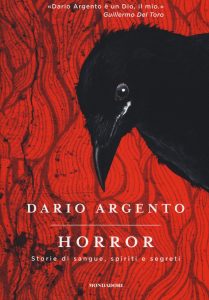Dario Argento – Horror. Storie di sangue, spiriti e segreti
Paperback, 160 pages Publisher: Mondadori Language: Italian
In March 2018 Horror arrived on the Italian bookstores’ shelves. Its English title aside, this short story collection penned by Dario Argento and published by Mondadori isn’t likely to reach the maestro’s anglophone fans, it being in Italian language.
Those familiar with Dario Argento’s cinematic universe are certain to recognize his approach to storytelling here: focus on atmosphere and action over logic, sketchy characterization (women frequently represented as either blatant sexual objects or fearsome witches), individual striking episodes taking precedence over general narrative coherence.
The thin volume (under two hundred pages) unites six short stories, each one named after a particular building or place, united under the crimson soft cover.
Story one, Notte agli Uffizi (“Night at the Uffizi”) uses real events – preparation for filming THE STENDHAL SYNDROME (1996) – as a springboard for a tale of the macabre and the fantastic. It’s quite graphic and perverse, not shying away from some horrible – and misogynistic – details.
Set in the historical centre of Rome, Rosso porpora alla Biblioteca Angelica (“Crimson at the Angelica Library”) tells of an Italian-American historian conducting research at a large public library. Soon after an encounter with a sexy stranger, he finds himself chased through the streets of Rome by a hitman, rushing past many landmarks towards a rather confusing climax. The protagonist’s stream of consciousness isn’t particularly original. Not unlike most Argento’s films, there’s not much psychology or attempts at credibility, with everything geared towards suspense. Rosso porpora alla Biblioteca Angelica , features violence to cats, highly fetichized and sexualized description of women and a protagonist incapable of making the right decisions. In short, it could be a literary follow-up to the famed “Animal Trilogy”. The most interesting aspect of the story is the setting – the very library Eleonora Giorgi enters in INFERNO, with the crucial scene playing out on the narrow scaffolding which runs the length of the room.
Next up is Villa Palagonia – perhaps the most disappointing entry in Horror. Set in Bagheria, at the Villa Dei Mostri near Palermo – that’s right, the one Kazanian mentions to Rose in INFERNO – thee tale starts off promisingly only to wind up an incoherent mess. A nameless narrator and his vaguely outlined friends are on a guided tour inside the infamous 16th century villa. A fleeting encounter with the supernatural takes place as the teller wanders off on their own into the forbidden depths of the villa.The story has rather evident flaws – unimaginative dialogue, the protagonist’s illogical behavior. Thankfully, tere’s also some loving description of the house itself. Villa Palagonia offers the same level of detail Argento utilizes when portraying architecture in his best films. Description of the house itself is more interesting than the pointless dream-within-a-dream story structure. Still, for all its shortcomings, this story has some value and charm to it.
Le Segrete di Merano (“The secrets of Merano“) is the most original, disturbing and unpredictable entry. Carlo, a city kid on the verge of puberty, is sent from Rome to spend a fortnight with his aunt in the Italian Alps. Soon Carlo gets unwittingly involved with a mysterious sect, sees a ghost and ends up in the clutches of modern day witches. If you’re going to read just one story from Horror, make it this one.
Set in the medieval times, Alchimie macabre al castello di Gilles (“Macabre alchemy at the Gilles castle”) tells of some unfortunate children who end up prisoners in the dungeon of a mad alchemist’s castle. One of the strongest stories in the collection, Argento doesn’t spare the gruesome details and the fact that the protagonists are innocent children pitted against cruel, barbaric and corrupt adults adds extra tension.
The sixth and final short story, Demoni a Singapore (“Demons in Singapore”) is the most action packed and far-fetched one (and the only one not to play out in Europe). This time around Maestro is in full splatter mode. The story reads like a synopsis of some demented comic book. As armed to the teeth mercenaries infiltrate a tropical island intent on massacring every inhabitant on the orders of a shadowy businessman, ancient forces are awakened and soon the island’s fauna rises up against the attackers. Fast-paced, over-the-top and with one or two unexpected twists, it’s a decent closing to an uneven collection.
Although Argento’s brief preface invites the reader to explore the depths of his imagination, reading the early stories one has a distinct sensation of being kept strictly on the surface of things. Granted, the stories are reasonably suspenseful and read easily, yet there’s decidedly little substance to this collection. While many readers may be attracted to the book due to Argento’s name on the cover, just as many are likely to walk away somewhat frustrated. There’s still some degree of consolation to be had: while Horror may not win any literary awards, it’s nevertheless proof that Dario Argento’s universe lives on, albeit transposed onto the page. These stories are visionary and plot hardly matters. That said, I would love to see Argento write a full-blown crime novel, a well-plotted romanzo giallo in the vein of his early Animal Trilogy thrillers.
Reviewed by Alex Bakshaev on 23 July 2018

